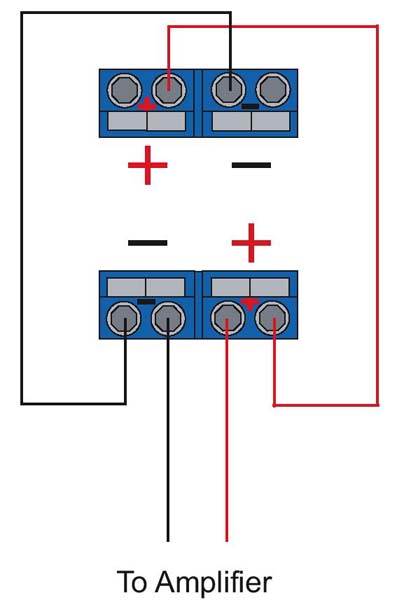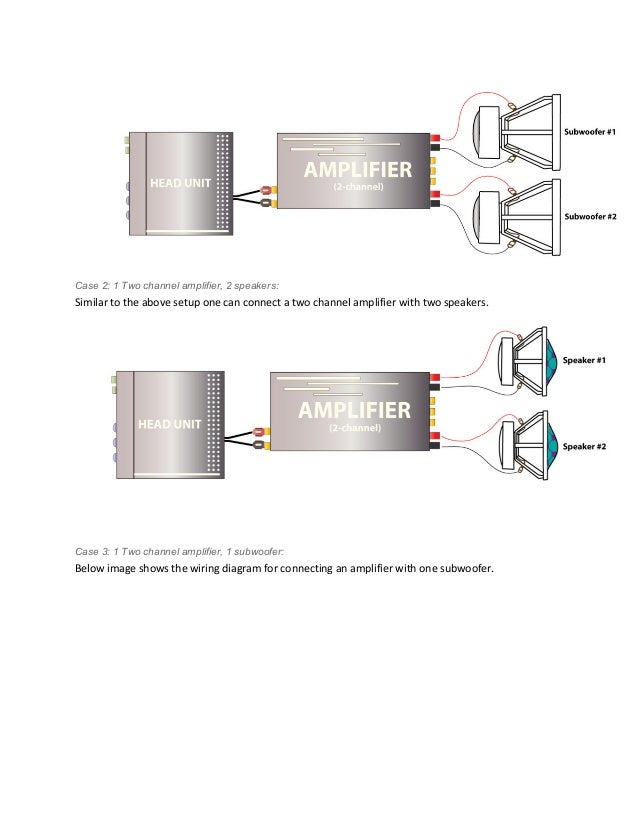How to Install a Car Amp
❤️ Click here: How to hook up 2 amps in a car diagram
Can I do this myself? After identifying the speaker wires, you cut each one and connect the end coming from the radio's output to the amp's input, and the end going to the car speakers to the amp's output.

I think that a 6-channel amp for the speakers plus a mono sub amp seems like overkill and expensive. I'm a little confused about the factory wires that go to the speakers. Now you'll want to.

How to Install a Car Amp - I am not familiar with those fans, so I can't help you with hooking them up.

How to Install a Car Amp Installing car audio amplifiers is one of the trickiest things a newbie car audio installer can attempt. Car amp installation requires that all sorts of panels be removed and that various wires be run all over the car. Installing car audio amplifiers is a step by step process which I have outlined here. If you have any questions please contact me by. Please do not attempt a car amp installation if you are not comfortable with the process. Leave it to a professional. Now here are the steps on how to install a car amp. There is also a wiring diagram below. NOTE: These directions assume you have already physically mounted your amplifier to a solid, non-conductive surface non-metal. If you have not purchased your power wiring be sure to read this article on. Disconnect the negative battery terminal. If you have a radio with a security feature such as a Delco-Loc, Eclipse ESN, etc. Try to find an empty rubber grommet that hides an unused factory hole. You can just put a hole in this grommet and run your wire through. Get out the power drill and steel drill bits. Before drilling make sure you know where the bit will end up once it's through the firewall. I usually make a small pilot hole and then increase the bit size until the hole is big enough for my wire. If you have a stepped bit i. Uni-Bit that would be great to use see photo. I recommend them highly. Don't skip this step. Caulk the gap between the inner diameter of the rubber grommet and the power wire if necessary to prevent water from running down the wire. StreetWires makes these type of two piece grommets which they call. It's easier to push 5-8ft of wire through the grommet than the other 15-20ft from the battery side. That's why you push the wire from the interior. This fuse protects your vehicle from burning up in case of the power wiring shorting out. It's not there to protect your audio equipment, it's there to protect your car. The wire between the fuse and the battery terminal will be unprotected, which is why you want this section to be as short as possible. The fuse size depends on the current the power wire will carry. Consult the owner's manual of your amplifier s to find out the maximum current draw of your system. You can also contact the manufacturer and ask them for that information. For multiple amplifiers you will need to add up the maximum current draw of each amplifier. Once you know the maximum current draw you'll know what size fuse to use. For example, if your maximum current draw is 50 amps then you'll need a 50 amp fuse. Do not insert the fuse until all other connections are made! Connect the power wire to the battery using appropriate connectors for the wire and battery terminal. For more help on. You will need to remove the rocker panel and kick panel covers to do this. Depending on your application, you can connect the power wire to the amplifier using appropriate connectors such as ring terminals, see photo or connect it to a power distribution block if you are using multiple amplifiers. You may also want to cover the wire in the engine compartment with wire loom prior to using wire ties. You can find this loom at auto parts stores and. You will need to follow a process similar to that of the power wire steps 8 and 9. However, run your RCA cables on the opposite side of vehicle. You do not want to run power wires and signal cables on the same side of the vehicle. This could induce noise into your system. Connect the remote turn-on wire to your amplifier using an appropriate connector such as a ring terminal. NOTE: The remote wire is what sends the signal telling your amplifier to turn on or off. It is a very important wire and your amplifier will not work without it. For multiple items using the remote wire you will want to. If you need to run wires through the interior of the vehicle, make sure you run them on the same side as the RCA cables. You do not want to run power wires and speaker wires on the same side of the vehicle. This could induce noise into your system although it is less likely than picking up noise through the RCA cables. Most speakers have two terminals of varying sizes. The larger terminal is the positive terminal and the smaller is the negative terminal. NOTE: If your speakers were previously connected to powered by your head unit you will need to first disconnect the speakers from the head unit. You cannot have your head unit AND your amplifier connected to the speakers. This will cause damage to your electronics. Any metal point on the vehicle should work since they all lead back to the negative terminal of the battery. This negative power wire should be short and of the same diameter as the positive power wire leading to the battery. When connecting the negative power wire to ground, you may need to scrape some paint from the grounding surface. If you have a Dremel type tool with a metal brush these work great wear eye protection. This will ensure better contact between the negative power wire terminal and the vehicle ground. CAUTION: If you must drill a hole in the vehicle to connect the chassis ground, make sure you know what you're drilling into. This is especially important when you are in the area of your vehicle's gas tank. A wrong move here could puncture the tank, cause a spark and set your vehicle on fire with you in it! If you are unsure then consult a professional. If you are you will need to charge it first. This can also be done at the fuse holder. You just installed a car audio amplifier. Now you'll want to. See the instructions below. You may also be interested in How to Install Your Own Car Stereo System. It covers many topics including in depth car audio amplifier installation. Level and Gain Setting for Car Audio Amplifiers Level setting, done by ear, is more art than science. It can be done using an oscilloscope but since few people have one of those laying around we'll cover doing it by ear. Basically you want to start with the first component in the chain the head unit and work your way to the last component the amplifier. NOTE: You can be exposed to very loud volumes during this process so it is wise to wear hearing protection in most cases. You should still be able to hear the distortion through the attenuated hearing protection. If you have more than one RCA pair you will want to set each gain adjustment separately. Make sure your fader and balance controls are set to the channel you want to adjust first. This can be an individual channel if you have individual gain adjustments or a pair of channels if you have one gain for two channels. What we want is as pure a signal as possible. Hard rock would be a bad choice here. Try something cleaner, maybe acoustic, that you're familiar with. When you hear it, stop and back off slightly until you no longer hear it. If you don't hear distortion, even when the volume is all of the way up then you have a quality head unit. That's what we're looking for. Adjust it's input gain until you begin to hear distortion. As before, turn up the gain until you hear audible distortion. This should be audible even with earplugs in. But honestly, if you have to wear earplugs to listen the distortion level is probably not a factor : That's it. Play some music and verify that everything sounds right. You've just learned to properly adjust the settings on your car audio system. If you have any problems after the installation be sure to read over these three articles.
How to Connect Multiple Amps And Wire Up A System
This is a passive system. Any longer, you should use 2-gauge piece. How to Install a Car Amp Installing car audio amplifiers is one of the trickiest things a newbie car audio installer can attempt. As for being able to add another sub in the future, I'm afraid most 4-channel amps can't support the lower impedance or prime power requirements of adding a second sub to its bridged channels, so you'd need to get a second amp. In your case, instead of running RCA cables from the receiver to the amp, you'd use a second 9-conductor cable from the speaker wiring on the receiver harness to the amp's resistance-level inputs. Click on for details. Lots of people use a ground block to connect the grounds of multiple devices to the same chassis point. I do know some car audio.



